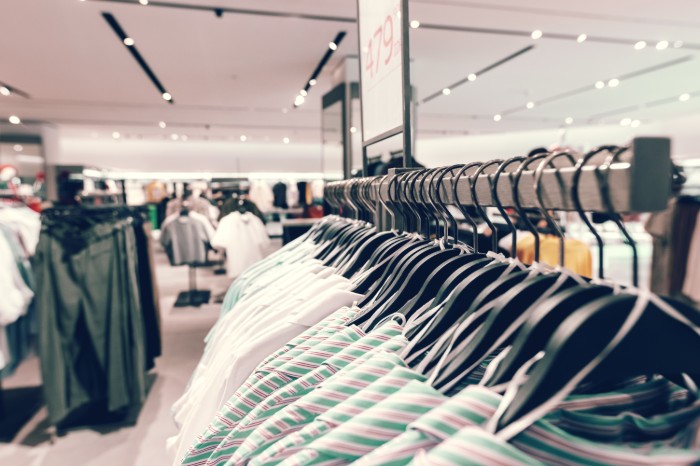Have you ever gone to the movies and bought popcorn to enjoy while you watch? If you have, you’ve probably noticed how expensive movie theater concessions are. Most theaters’ going rate for a medium popcorn is $7.99, but grocery stores sell the same popcorn for a fraction of the price.
Even with overpriced concessions, movie theaters sell millions of bags of popcorn every year. So how do the theaters get away with these prices and why is it all so expensive, anyway?
To answer those questions, Coupon Chief examined seven popular products to analyze their pricing. From printer ink to diamond jewelry, these are some of the most marked-up products on the market. However, you pay for them every day. So...are you getting what you pay for?
Learn more about the science and use of price markups in retail.
Even with overpriced concessions, movie theaters sell millions of bags of popcorn every year. So how do the theaters get away with these prices and why is it all so expensive, anyway?
To answer those questions, Coupon Chief examined seven popular products to analyze their pricing. From printer ink to diamond jewelry, these are some of the most marked-up products on the market. However, you pay for them every day. So...are you getting what you pay for?
Learn more about the science and use of price markups in retail.
What is a Price Markup?
Before we dive into the seven most overpriced products, it’s important to understand what price markups are and how companies use them.
A price markup is the retail price a business sells a given product for, compared to the cost that company pays to create the product. The formula for price markups is:
Markup percentage = (Retail sale price - Manufacturing cost)÷ Manufacturing cost
Let’s look at an example:
Movie popcorn costs an average of $0.99 per medium container for theaters to make. However, it’s sold to movie-goers at $7.99 per serving. The markup for the popcorn is 707%, or:
7.07 or 707% = ($7.99 - $0.99)÷ $0.99 Companies most often use price markups to make a profit on the products they sell. If a business sold its products for the same amount of money it took to manufacture them, the business would never grow past its breakeven point.
Successful companies also use price markups to fund other business operations, including marketing and advertising campaigns, research and development for new products, and fulfilling the salaries of employees.
A price markup is the retail price a business sells a given product for, compared to the cost that company pays to create the product. The formula for price markups is:
Markup percentage = (Retail sale price - Manufacturing cost)÷ Manufacturing cost
Let’s look at an example:
Movie popcorn costs an average of $0.99 per medium container for theaters to make. However, it’s sold to movie-goers at $7.99 per serving. The markup for the popcorn is 707%, or:
7.07 or 707% = ($7.99 - $0.99)÷ $0.99 Companies most often use price markups to make a profit on the products they sell. If a business sold its products for the same amount of money it took to manufacture them, the business would never grow past its breakeven point.
Successful companies also use price markups to fund other business operations, including marketing and advertising campaigns, research and development for new products, and fulfilling the salaries of employees.
Products With Markups That Might Surprise You
From products you use every day like your favorite pair of blue jeans to once in a lifetime purchases like diamond rings, the following items are some of the most marked-up products on the market.
HP 27 Black Printer Ink sells for $22.00 at Best Buy, but the same ink can be bought from an independent retailer on Amazon for $5.50 per package. This means that Best Buy has implemented a 75% markup on what should be a very inexpensive purchase.
That seems like pennies on the dollar compared to its retail price, a whopping $1,099.00 on average. In fact, that retail price is more than double the manufacturing cost. However, this isn’t the biggest markup Apple has ever gotten away with.
Printer Ink With a 75% Markup
Many of us use printers and printer ink every day. However, did you know printer ink has been named one of the most expensive liquids in the world?HP 27 Black Printer Ink sells for $22.00 at Best Buy, but the same ink can be bought from an independent retailer on Amazon for $5.50 per package. This means that Best Buy has implemented a 75% markup on what should be a very inexpensive purchase.
The iPhone 11 Pro Max With a 124.06% Markup
Your smartphone may seem like the latest and greatest in handheld technology, but it’s actually an inexpensive product to make. In fact, the most recent data suggests that the iPhone 11 Pro Max costs a mere $490.50 for Apple to manufacture on average.That seems like pennies on the dollar compared to its retail price, a whopping $1,099.00 on average. In fact, that retail price is more than double the manufacturing cost. However, this isn’t the biggest markup Apple has ever gotten away with.
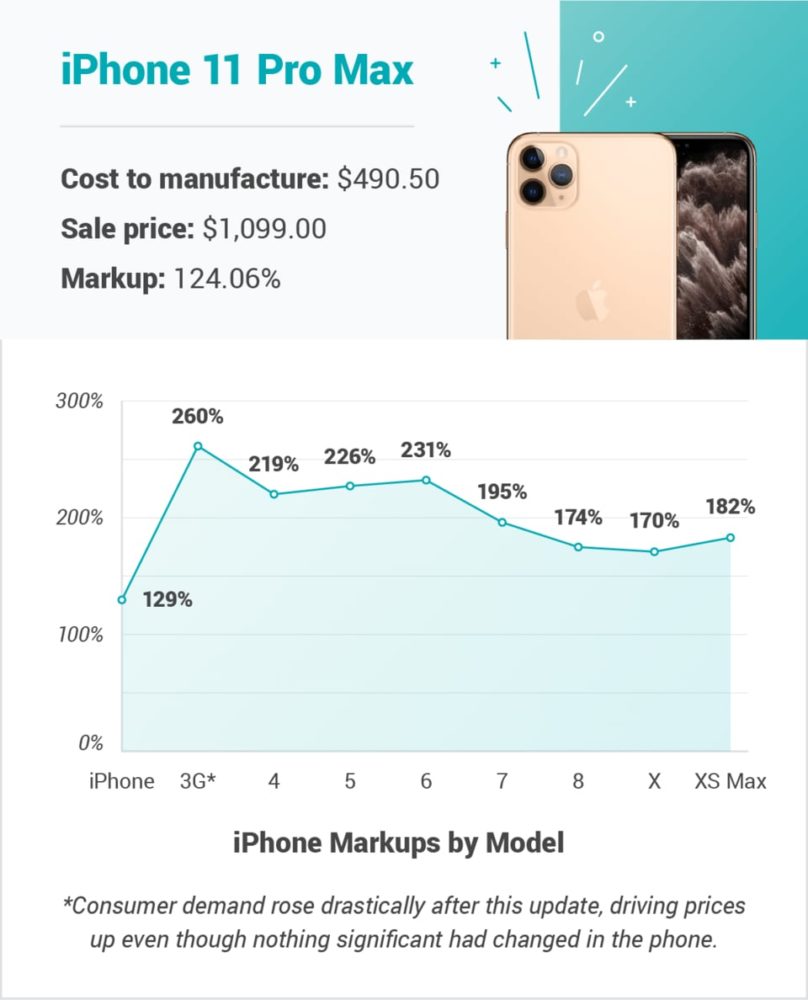
As shown in the graph above, the largest markup Apple ever implemented was found in the iPhone 3G, the second model ever released to the public.
You might be trying to recall just what was so special about this model. However, not much had changed between the 3G model and its predecessor, the original iPhone. So what fueled this crazy-high markup?
We attribute this spike to two important factors:
1. The cost of producing the 3G compared to the original iPhone: There aren’t many differences between the two models, leaving the overall cost of manufacturing relatively unchanged for Apple.
2. A drastic increase in consumer demand from the original iPhone to the 3G model: After the original iPhone gained popularity, consumer demand rose sharply after the announcement of an updated model, the 3G iPhone. The original iPhone sold 300,000 units in the first weekend, while the 3G version sold over 1 million units in the first weekend. This dramatic increase gave Apple the freedom to raise prices despite an unchanged cost of manufacturing.
You might be trying to recall just what was so special about this model. However, not much had changed between the 3G model and its predecessor, the original iPhone. So what fueled this crazy-high markup?
We attribute this spike to two important factors:
1. The cost of producing the 3G compared to the original iPhone: There aren’t many differences between the two models, leaving the overall cost of manufacturing relatively unchanged for Apple.
2. A drastic increase in consumer demand from the original iPhone to the 3G model: After the original iPhone gained popularity, consumer demand rose sharply after the announcement of an updated model, the 3G iPhone. The original iPhone sold 300,000 units in the first weekend, while the 3G version sold over 1 million units in the first weekend. This dramatic increase gave Apple the freedom to raise prices despite an unchanged cost of manufacturing.
A Pair of Blue Jeans With a 490% Markup
Markups don’t just occur from the manufacturing price to the retail price. Markups can also be found in the price difference between popular brands and generic versions. They can also be found in the difference between designer blue jeans and more budget-conscious options.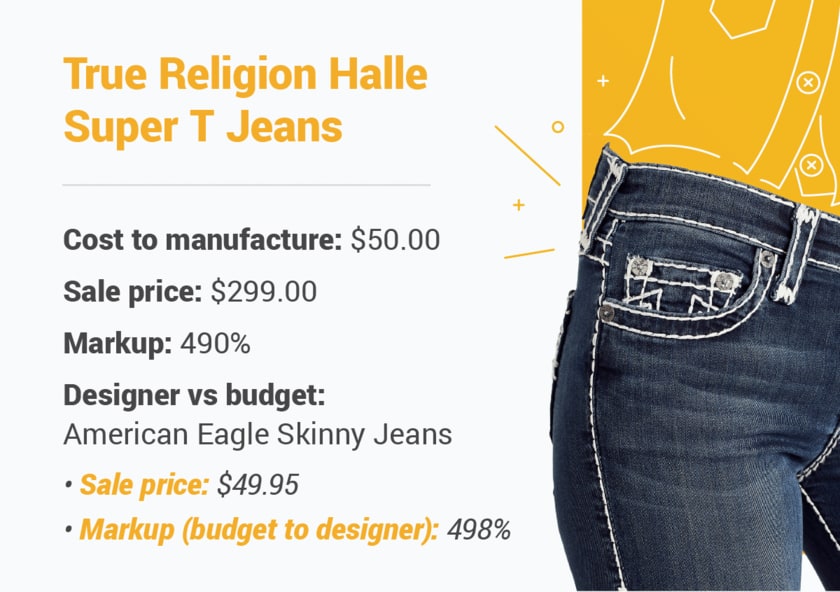
For True Religion fans, you could be paying a near 500% markup on your favorite pair of blue jeans. The True Religion Halle Super T Jeans sells for $299.00 per pair but cost only $50.00 to make. This equates to a markup of 490% on average.
However, American Eagle Skinny Jeans, a more inexpensive version, sell for only $49.95. Compared to True Religion Jeans’ $299.00 sale price, this is a 498% markup.
However, American Eagle Skinny Jeans, a more inexpensive version, sell for only $49.95. Compared to True Religion Jeans’ $299.00 sale price, this is a 498% markup.
A Loose Diamond With a 1,204.66% Markup
It’s no secret that diamonds of any size are expensive –– hopeful grooms save for months to afford engagement rings and even the simplest of styles can cost thousands of dollars.The actual cost of diamonds might surprise you, though. In fact, a loose diamond could cost as little as $146.00 to mine, shape, and polish.
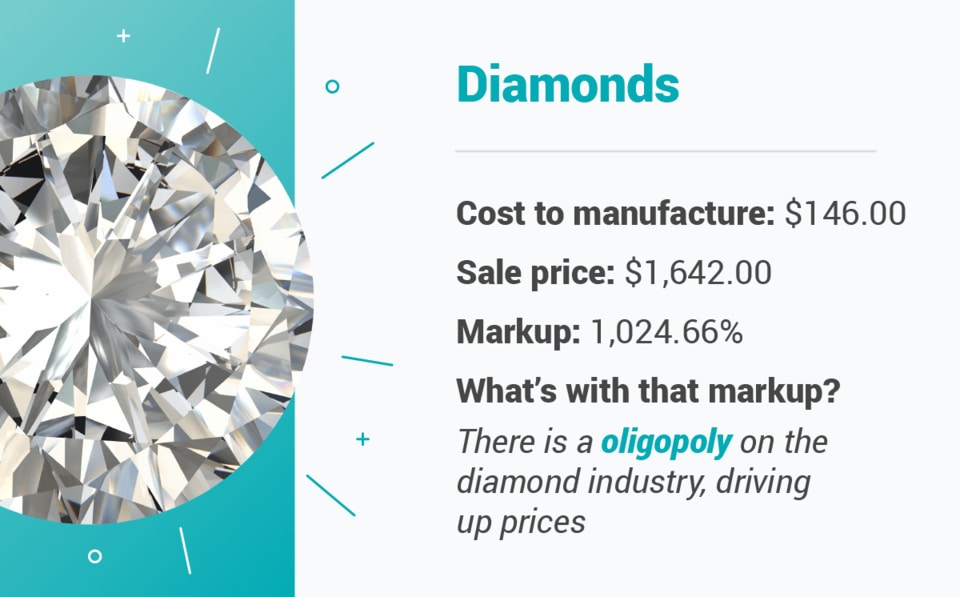
It’s a common misconception that diamonds are rare, expensive gems. In reality, they’re more abundant than emeralds, sapphires, rubies, and many other gemstones. However, the price difference is dramatic: a 1.00 carat diamond averages $7,000 compared to $100–$1,000 per 1.00 carat for another of these gemstones.
So what gives, diamond industry? While the history of the diamond industry is extensive and lends to today’s overpriced stones, the major contributor these sky-high prices is the oligopoly on the diamond industry.
Today, a handful of companies control the large majority of diamond mines across the globe –– these companies act as industry leaders because of their control, allowing them to set prices as high as they like.
So what gives, diamond industry? While the history of the diamond industry is extensive and lends to today’s overpriced stones, the major contributor these sky-high prices is the oligopoly on the diamond industry.
Today, a handful of companies control the large majority of diamond mines across the globe –– these companies act as industry leaders because of their control, allowing them to set prices as high as they like.
Your Daily Cup of Coffee With a 2,900% Markup
If there’s one thing you take away from this article, make it this: make your coffee at home. Otherwise, you could be shelling out cash for a coffee that’s been marked up 2,900% over its manufacturing cost.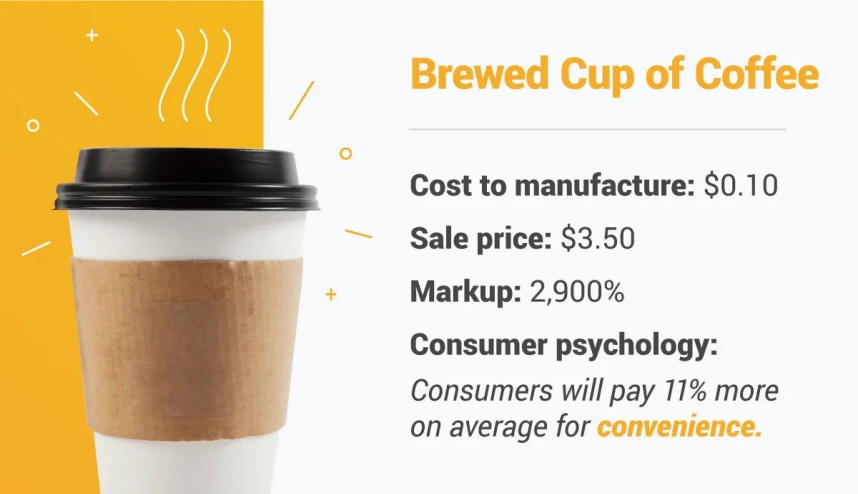
Consumers’ never-ending quest for convenience is what fuels this markup. Starbucks and other coffee shops know that customers want their daily dose of caffeine to be as easy to get as possible. With drive-thru options, online ordering and app reward points, Starbucks is preying on consumers who have no idea their $3.50 coffee costs about $0.10 to brew. In fact, consumers spend an average of $2,000 every year just to get their Starbucks fix.
Price Markups Across Industries
Based on available production pricing data, here are the average price markups across major industries:
• The home and family industry: 537%
• The fashion and apparel industry: 671%
• The entertainment industry: 912%
• The healthcare industry: 1,220%
• The education industry: 1,260%
• The food and drink industry: 1,310%
• The tech and electronics industry: 2,420%
• The home and family industry: 537%
• The fashion and apparel industry: 671%
• The entertainment industry: 912%
• The healthcare industry: 1,220%
• The education industry: 1,260%
• The food and drink industry: 1,310%
• The tech and electronics industry: 2,420%
The Bottom Line: Know What You’re Paying For
Omnichannel marketing in retail is now more important than ever. While some of these markups might have your head spinning and your wallet groaning in protest, it’s important to remember that most companies use these price markups for very good reasons. Research and development, marketing campaigns, and company benefits are all funded by price markups and help to contribute to the products you love and use every day.Growth Hackers is a cutting-edge retail marketing agency committed to helping entrepreneurs, business owners, and marketers grow their business or startup. We'll help you build your brand, reach your target audience, get leads and increase your revenue. If you're serious about propelling your business to the next level, send an email to Growth Hackers today and you'll start getting results in no time.

